Samsung Galaxy Nexus & Ice Cream Sandwich Review
by Brian Klug & Anand Lal Shimpi on January 18, 2012 1:34 PM ESTDisplay
Another huge axis of improvement lately has been the mobile display category. It’s an ironic turn of events which has led to the mobile side being where all the improvement is taking place for displays in general. On one side of the industry we have the PC display market, which is currently locked in a dramatic race to the bottom (1080p 27" displays, decline of the 16:10 aspect ratio, etc.), and on the other side we have mobile displays where OEMs are rushing to outdo each other every major product cycle. In fact, 2012 might go down as the year when mobile display resolution eclipses the desktop.
Back on topic however is the Galaxy Nexus display - it’s a 4.65" diagonal, Super AMOLED HD 1280x720 affair. If you’ve followed Samsung’s AMOLED naming scheme, you can pretty much tell everything that there is to superficially know about the display just from the name. Super connotes an optical bonding (read: no air gaps or their pesky 4% Fresnel reflections) of the display and the entire stack above it, consisting of capacitive layer and top glass.
HD connotes, well, 720p HD, and finally the absence of Plus connotes the presence of PenTile RGBG. On that last note, we made a prediction that PenTile would be very hard to see on the Galaxy Nexus based on some pixel pitch calculations, and this turns out to be the case.
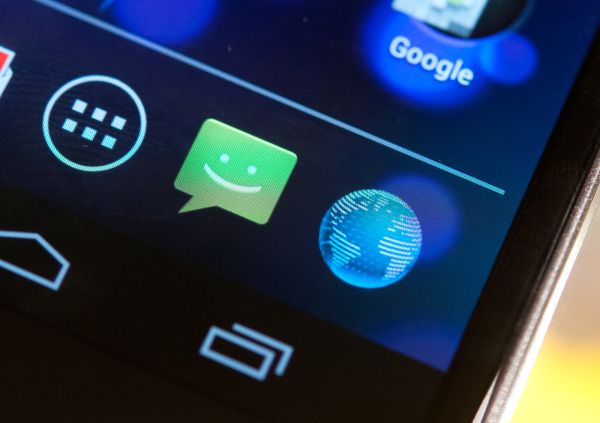
Decently close to the Galaxy Nexus display with a macro lens - hard to make out any subpixels
For me at least, the Galaxy Nexus display exceeds my visual acuity - I cannot pick out subpixels at all on the Galaxy Nexus. Quite literally, the RGBG subpixel stripe is now small enough that it is beyond visual acuity at standard viewing distance (1 foot).
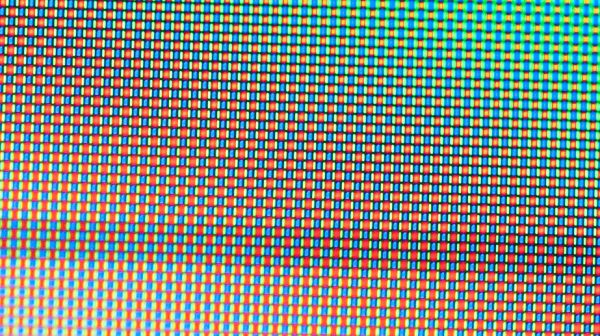
Extreme macro shot of the Galaxy Nexus' display for illustrative purposes showing PenTile RGBG
If 2011 was the year where OEMs countered the iPhone’s retina display with qHD panels, 2012 is the year where they finally start to exceed that 330 ppi number. It seems as though 1280x720 WXGA will be the new WVGA or qHD for 2012, and already there are a bunch of 720p devices arriving on the market - phones like the HTC Rezound, LG Nitro HD, Galaxy Note.
Last time we compared pixels and subpixels per inch in the diagonal on a few phones. Many people pointed out alternative ways to compute everything, but in the end the aim was to set expectations for how visible PenTile would be, and the conclusion was: not very. This time, I think it makes sense to compare the actual angular subtense of the subpixels so we can appreciate whether they’re visible or not, rather than deal with another back and forth about whether measuring along the diagonal is valid or not anymore. It's easy to be lazy and just do things entirely wrong, but the actual angular subtense of a subpixel should be the canonical measure we use to determine whether you can see pixels or not, since that's the annoyance after all. Visual acuity for the average human eye is 1 arcminute (something drilled into my head from endless optical engineering classes), and perfect human vision is just below that at around 0.7 arcminutes. I have 20/15 which puts me around 0.75 arcminutes, and I can't see subpixels on the Galaxy Nexus unless I really, really try.
It’s actually a challenging thing to codify whether or not you’ll be able to see PenTile, since color (wavelength) makes a huge difference. Further, visual acuity is itself a hard thing to qualify - for example, consider how much resolution is enough to identify versus detect something, and then how human vernier acuity (aligning something) is very good, and all of this is a function of the light's wavelength. For example, the on-off pattern when looking at solid green is just about the worst case possible - it’s a square wave (100% modulation) in the green right where the eye is most sensitive. In the past, it struck me that other members of the tech press were perhaps unconsciously taking photos of the green battery indicator to show the presence of PenTile or not since that's where subpixels are most visible. As an aside, most of the UI is now blue in 4.x (including battery indicator) which the eye does not have very good sensitivity to - just try focusing on something entirely blue - is this a coincidence or conscious decision to mask bad displays? For comparison, when displaying white obviously subpixels largely disappear into a sea of light. If you look at a green solid region now, you’d be hard pressed to make out the individual subpixels, and the table explains why:
| Display Subpixel Angular Subtense lower is better, human eye ~1 arcmin) | |||||||
| Phone | X subpixel angular subtense at 12" | Y pixel angular subtense at 12" | |||||
| HTC Rezound | 0.280 | 0.839 | |||||
| iPhone 4/4S | 0.290 | 0.869 | |||||
| LG Nitro HD | 0.293 | 0.878 | |||||
| Motorola Droid | 0.361 | 1.082 | |||||
| Motorola Atrix 2 | 0.373 | 1.118 | |||||
| Galaxy S II | 0.440 | 1.320 | |||||
| Galaxy Nexus | 0.454 | 0.907 | |||||
| Infuse 4G | 0.461 | 1.382 | |||||
| Droid 3 | 0.520 | 1.040 | |||||
| Droid RAZR | 0.559 | 1.118 | |||||
| Droid Incredible | 0.568 | 1.136 | |||||
| Nexus One | 0.568 | 1.136 | |||||
| Galaxy S / Nexus S | 0.614 | 1.228 | |||||
The interesting thing about the table is that it very much backs up my subjective impressions of just how visible subpixels were on previous phones. The Nexus S / Galaxy S had comparatively gigantic subpixels, and I can't stand looking at those displays to this day. Move up the line and you get increasingly better (I've sorted by x/horizontal angular subtense), with the HTC Rezound exceeding the iPhone 4S. Note that you have to consider the adjacent unlit subpixels as well to really arive at a conclusion for how visible things are going to be - on the PenTile RGBG displays, that means one adjacent unlit subpixel, and on RGB stripe, two unlit subpixels (assuming we're talking worst case 100% Green, 0% Blue, 0% Red).
While Samsung has been able thus far to increase its AMOLED pixel pitch considerably, it has come with one unintended effect. That effect is a bit of pixel inhomogeneity which results in a somewhat grainy look to the display under certain circumstances. While neither device we tested had it, others have reported lines or splotches. There’s a word for these inhomogeneities in display luminance, and it’s “mura.” The variance is no doubt very minor, but the eye is great at picking out these small changes, and it’s particular visible in certain contexts, like the grey loading screen on the Android Market. So far getting a good photo of this effect has eluded me, however, it looks like a light film grain. Stated another way, it's like a fixed pattern noise that exists at all times on the display, which seems particularly visible at some brightness levels. To be honest, it doesn’t annoy me any more than IPS display “grain” annoys me - you just get used to it after a while.
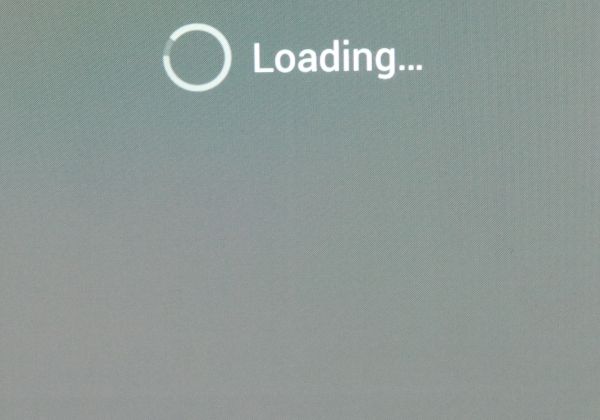
Photographing the mura on the Galaxy Nexus' display has proven a challenge
These inhomogeneities also sometimes manifest themselves as visible strips of different luminance. I haven't seen any on either of the Galaxy Nexi we have, but if you do get hardware with annoying inhomogeneities, I recommend just swapping. Again, getting photographs of the grain has proven challenging.
The display’s surface is curved, though the radius of curvature is nowhere near as curved as some of the early teaser photos would’ve had you believe. Total sag ends up being around 1.5 mm, giving a radius of curvature around 1.5 m - needless to say, it’s a very gentle curve. The other noteworthy thing about the Galaxy Nexus is Samsung’s choice of glass. Lots of people have noted that the Galaxy Nexus isn’t adorned with Corning’s popular Gorilla Glass, though it’s still a kind of fortified (and no doubt alkali-aluminosilicate) glass. It’s impossible to tell exactly what kind of glass is on the Galaxy Nexus without destructive testing on either Samsung’s or Google’s review unit. That said, if anyone breaks a display, send me the broken top glass and I’ll be able to do some compositional analysis. As an aside, compositional analysis of the top glass from different phones is something I’ve wanted to do for a while now, but requires sourcing broken glass.
We’ve also done all the usual measurements on the Galaxy Nexus - luminance and color temperature at different brightnesses selected in settings, and a run through HCFR using Francois’ excellent Screen Test Patterns app.
First off are the display charts taken at a number of different brightness settings by dragging the slider around in settings. Traditionally AMOLED has struggled to keep a flat white point. Here the Galaxy Nexus isn't bad at all, hovering just below 6500K.

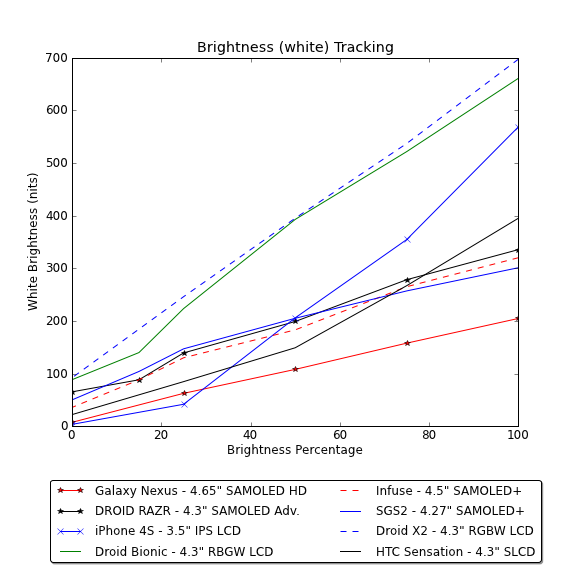
The Galaxy Nexus manages to stay reasonably close to 6500K even as brightness changes across its full range. The brightness curve is also nice and linear, though it tops out at just over 200 nits at maximum brightness.
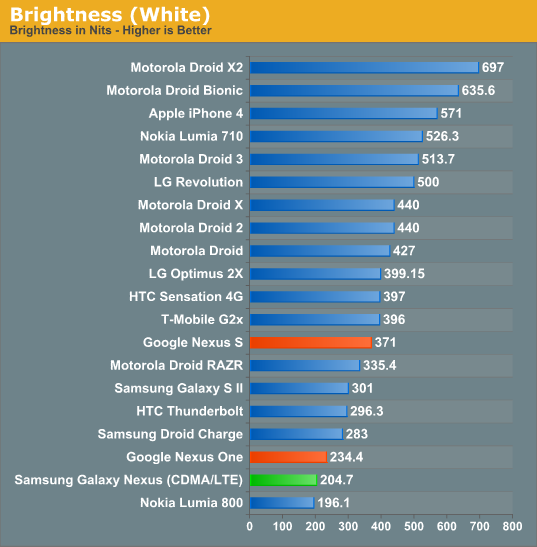
The HCFR plot and color.chc file tell an even more interesting story. The CIE chart shows how AMOLED continues to have a gamut much larger than sRGB (which is the inner triangle). It’s awesome to have more spectrum, but bad when mapping sRGB to this color space without more management, and leads to AMOLED’s oversaturation stigma.
There are more interesting things inside, too. Color temperature at 100% brightness and displaying different shades of Gray stays pretty close to 6500K as well. Gamma ends up almost all over the place, unfortunately.
The nice thing about ICS on the Galaxy Nexus is also increased color depth in many places. Previously Android’s gallery many times appeared in RGB 565, leading to visible banding. This is now almost entirely gone as well.
Viewing angles on the Galaxy Nexus, like other AMOLED devices, is superb as well. There’s practically no shift in either horizontal or vertical angles. Outdoor viewing has gotten better on AMOLED with a bunch of improvements - better AR coatings, no more air gaps, and other coatings. Out in the brightest of sunlight it can still be hard to read, however.


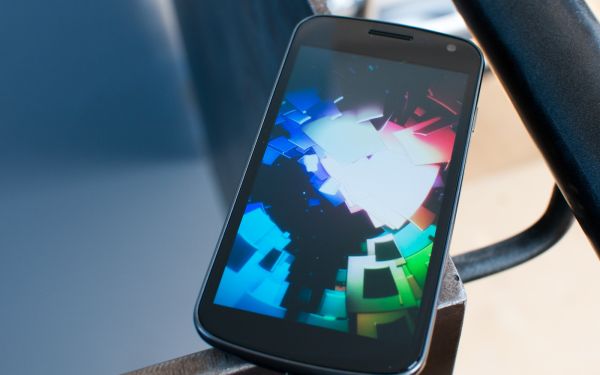
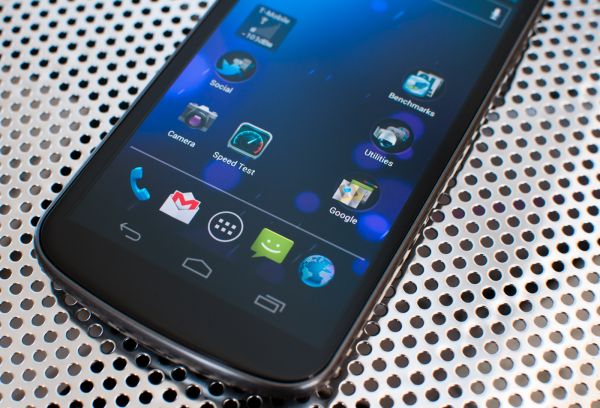





















185 Comments
View All Comments
CoryS - Thursday, January 19, 2012 - link
Guys, this is a NEXUS it is a dev device. That primary reason I got it was because of this...better hardware will be right around the corner...but we won't see another Nexus..especially on Verizon for some time.It is refreshing to have a community to fix issues OEMS ignore (yes even Apple) for a change. This is my first unlocked device, and i can't see myself ever going back to anything else.
medi01 - Friday, January 20, 2012 - link
Wake up, Smartphone market (worldwide):1. Samsung 24%
2. Apple 18%
Android vs Apple = 3 vs 1 and gap is raising.
Most people turn to apple due to FUD, like this article. Google "steppit out of the shade of its competitor" having three times Apple's market share and much more usable interface (try to quickly access settings like wlan/bluetooth/gps on ios)
steven75 - Friday, February 10, 2012 - link
LOL dont you get it? You don't *need* to fiddle with those settings on iOS necause the battery life is so dramatically better.Also, funny reading this comment after Apple's Q4 report where they dominated.
Omid.M - Wednesday, January 18, 2012 - link
I hope Samsung puts out this phone based on GN aesthetics but Exynos 5250 (plus MDM9xxx multi-mode/LTE modem) and blows away the competition.@moids
Chumster - Wednesday, January 18, 2012 - link
Could someone clarify on what GPU/CPU he was talking about coming in Q2 devices? Cray? Crate? It was hard to pick up on my headphones.mmp121 - Wednesday, January 18, 2012 - link
KraitRead below:
http://www.anandtech.com/show/4170/qualcomms-annou...
Enjoy!
Conficio - Wednesday, January 18, 2012 - link
Really, Google can't survive once Walled Garden platforms like iOS gain traction.While it is nice to control the OS (Chrome OS) on PC like devices and nice to stick it to Microsoft, it is essential in the world of smart phones. Google clearly saw that Apple did the unthinkable, wrestle control of the phone's apps away from the networks. That is an existential thread for Google. If there is a billion PC users world wide, there is a multitude of smart phone users, sooner or later.
If a hardware manufacturer and OS provider like Apple (or Microsoft) controls the apps that can be provided to the phone and features, move from browser to apps on phones, then this is the end of (a profitable) google sooner or later.
From anther point of view, Google is a huge data center that provides you with data services on their computing power (and you pay for it with advertisement somehow). Apple is a hardware manufacturer that sees it necessary to control the software to deliver a good user experience. Sure, two different approaches to a smart phone OS.
hackbod - Tuesday, January 24, 2012 - link
"Google clearly saw that Apple did the unthinkable, wrestle control of the phone's apps away from the networks."There is this weird thing I see expressed a lot, as if Android is a reaction to the iPhone.
It is not.
In this particular case, it is obvious: Android's SDK was made available a few months after the original iPhone was on sale, well before there was *any* native SDK for the iPhone. At that time Apple's very clear official policy was that web-based apps was the One True Way to create applications for their phone. There was no concept of an App Store, no phone apps except what Apple shipped built in to the iPhone, nothing wrestled away from the networks in that department.
If Android was a reaction to anything, it was to the current situation on desktop PCs, with one company controlling that platform, and being able to quite strongly dictate and control its ecosystem and thus large parts of the computer industry.
One of the goals of Android was to try to keep that from happening in the upcoming mobile industry, by creating an open platform so that everybody in the industry can compete as equally as possible.
(And an aside -- this also makes it funny to see the recent stuff going around about Google "losing control" of Android. Android was very much set up so that no one company, not even Google, could have anything like the control that Microsoft does over Windows. This should be pretty obvious to anyone who wants to actually write thoughtful articles on the topic and not just link bait.)
bjacobson - Wednesday, January 18, 2012 - link
Can you talk more about this? From Diane Hackborne's post here (https://plus.google.com/u/0/105051985738280261832/... it sounds like the "limitation" is memory bandwidth in that hardwares that are "laggy" are laggy because they can't render to the entire screen 2 and 3x per frame for all the overlays. Which wouldn't seem like so much of a Tegra2 limitation in my opinion considering it has the power to play games like Quake 3 at 1600x1200 @ 60fps (I think...right?). What are your thoughts?hackbod - Tuesday, January 24, 2012 - link
I don't know about the performance of Tegra 2 playing Quake, but you need to be very careful when comparing the traditional 3d workload that GPUs are highly optimized to support (as exemplified by Quake) vs. the performance rendering 2d graphics.Traditional 3d games tend to rely, for example, on triangle rendering as much if not more than raw pixel fill rate, and GPUs are designed to be able to do that fast. When drawing 2d scenes, there are very few triangles but those triangles cover very large parts of the screen and are rendered as overlapping layers.
On all of the hardware I have seen, for 2d rendering raw memory bandwidth (determining the number of times every pixel can be touched per frame) is the #1 impact on performance.
Look back at that post -- for a typical scroll of all apps in launcher, without using overlay tricks (which aren't available on Tegra when the screen is rotated), you are looking at touching every pixels about 4 times to render all the layers and composite them to the screen. This is just not a typical 3D game workload.